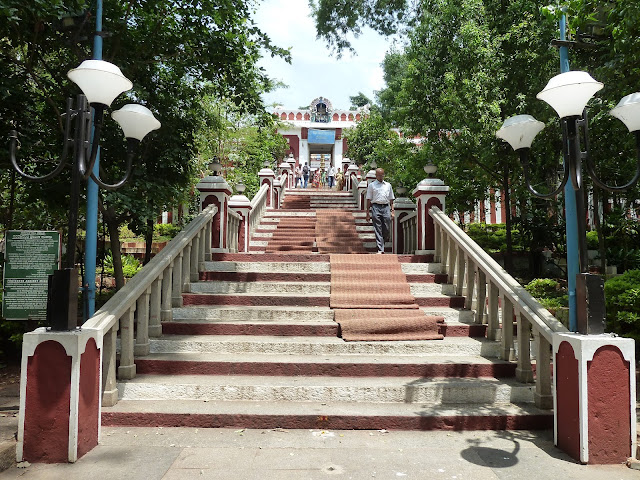Above is the west entrance to the temple on Sampige road
Above is the inside of the temple, north side
Above, to the left of the Garudakamba is the entrance from the east side of temple...one has to climb several steps to enter the temple from this entrance.
This above is the temple door from Sampige road.
This above is the door leading into the temple from the steps one takes from Temple road on the east side of the temple
Harikates were held in the evenings during the 60s and 70s (maybe even now. I don't know). For those who don't know what Harikathe is: Harikathe are usually stories from Hindu mythology, with morals, told by story-tellers who are usually old men who are very skilled in dramatic recital or or singing these stories in prose or verse form with explanations. Some used simple musical instruments or were accompanied by musicians. People sat on the floor, under the covered space between the pillars and the wall listening to the Harikates. My memory of the Harikates is that of old Brahmin widows with shaved heads wearing red saris, sitting, leaning against the pillars and listening to the stories. My grandmother dragged me to those Harikates. Now the demography of Malleshwaram has changed and I doubt if many Kannada speaking brahmin families are in Malleshwaram. Even if they are , I am sure people watch TV than come to the temple to listen to Harikathes.
Thank God, This space has not changed! I love the red and white of the walls and the red-oxide of the floors!
There was no carpet in those days to protect our feet from the granite slabs burning under the afternoon sun!
Above is the north wall of the temple, with Sampige road in the front and Subramanya temple to the right.
In the 70s, when I was a kid, there weren't this many Nagarkallus as seen above. There were just about 20 or less, placed between the two trees. Look at these rows and rows of Nagarkallus ! These stones are a LIE to the booming population of India's fertile population!
These are rows of Nagara kallus set here by childless devotees, praying to have kids. This is to the west, outside the temple.
This is the eastern entrance to the temple. The steps start from here to climb up to the temple.
On Shivratri, thousands of people form serpentine lines, on these steps to get in and pray to Shiva and get blessings
This is one temple where my slippers were NOT stolen! Was Shiva keeping an eye on them when I was inside praying? Are the thieves in Malleshwaram too lazy to steal? Are my slippers too old and shabby...not worth stealing?
I don't know what this decrepit wooden structure above is but it is in a park like thing near the temple
If someone would take aerial photos from a drone, we could see in the photos of Kadumalleshwara temple and the adjoining Nandeeshwara temple and Kalyani. A photo taken from a greater height would capture not only these two temples and Kalyani but also the Sankey Tank, nearby. To me, this indicates that Malleshwaram is a fertile area with good ground water resources.
I wonder how many lakes (kere-galu) existed in the past, in and around the Malleshwaram location, which have been built over ? In the 70s, I remember, the existence of a marshy waterbody, just where the Chowdiah Memorial hall is, at present. This marshy water-body, I am sure was the backwaters of adjoining Sankey tank.
Here are links to a few articles on lost lakes of Bangalore.
http://bengaluru.citizenmatters.in/bangalore-water-bodies-ndwi-images-research-7994
https://www.karnataka.gov.in/Parisaramahiti/Pages/Lost-lakes-of-Bangalore.aspx
https://urbaninstitute.group.shef.ac.uk/the-lost-lakes-of-bangalore/
Laura Fiorio, a German lady is apparently documenting the lost lakes of bangalore (https://www.thehindu.com/news/cities/bangalore/documenting-the-lost-lakes-of-bengaluru/article25664658.ece)





























No comments:
Post a Comment